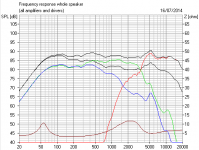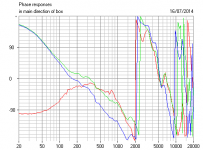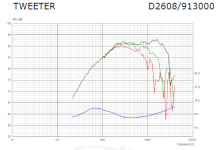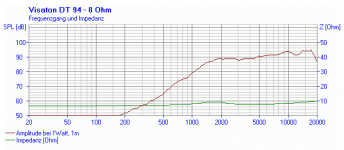Ok...I have posted this issue in a couple places...here's what I have figured out so far. My ears are sensitive...my Old ACI's Sapphire III's (Audio Concept Inc) were DVC and when one VC wasn't working because of a bad resistor, I could here it. (The difference in the volume.) I'm sure probably most here, could too!
My build is the Troels Nomex 164's I increased the R1051 from 1.1 ohm to 3.3 ohm. Still at loud levels it hurts my ears after a time. (CD's not so much.) Also, I listen from my Ipod regularly...so I know that is a consideration.
I am running 2 (or 3 depending on what I play) Adcom 2535 amps, with a B&K Ref 30 Pre-pro) with 200 watts going to my stereo pair!
I really want to build the Elsinores...but until a couple days ago thought these HDS tweeters were too "bright". Now I am sure it has to be the xover.
I used Audyn Plus caps, so I am going to try the Silver Janztens on the tweeter section. (The price difference is $8 each I think, compared to the Supremes)
Also I had issues with the solder strips Troels recommended, but I tested the ohm load on my speaks and they are right at 4.5 ohm so I don't think thats the problem!
I really like the way these HDS tweeters sound...so any help would be appreciated!
PLEASE READ THIS.....I have never listen to and enjoyed music at low to moderate levels like these speaker produce! (I have an 18 month old so I have no choice..😉 ) In any case I cannot believe how good these sound at low and moderate, or even mid high volumes. It's just when I really crank up the 200 watts that they start to fatigue. The ACI's didn't have this issue!
Therefore I am convinced it's the Cap...keep in mind the harshness is subtle!
Thanks in advance for any input...and thanks for these forums...freaking AWESOME!!!!!
My build is the Troels Nomex 164's I increased the R1051 from 1.1 ohm to 3.3 ohm. Still at loud levels it hurts my ears after a time. (CD's not so much.) Also, I listen from my Ipod regularly...so I know that is a consideration.
I am running 2 (or 3 depending on what I play) Adcom 2535 amps, with a B&K Ref 30 Pre-pro) with 200 watts going to my stereo pair!
I really want to build the Elsinores...but until a couple days ago thought these HDS tweeters were too "bright". Now I am sure it has to be the xover.
I used Audyn Plus caps, so I am going to try the Silver Janztens on the tweeter section. (The price difference is $8 each I think, compared to the Supremes)
Also I had issues with the solder strips Troels recommended, but I tested the ohm load on my speaks and they are right at 4.5 ohm so I don't think thats the problem!
I really like the way these HDS tweeters sound...so any help would be appreciated!
PLEASE READ THIS.....I have never listen to and enjoyed music at low to moderate levels like these speaker produce! (I have an 18 month old so I have no choice..😉 ) In any case I cannot believe how good these sound at low and moderate, or even mid high volumes. It's just when I really crank up the 200 watts that they start to fatigue. The ACI's didn't have this issue!
Therefore I am convinced it's the Cap...keep in mind the harshness is subtle!
Thanks in advance for any input...and thanks for these forums...freaking AWESOME!!!!!
Troels Nomex project you have built is by default a non fatigueing
speaker IMO but since you previously owned ACI speaker who was not so
revealling at lower listening volumes, current speakers being brighter
make you feel that way. You can pad the tweeter level as much as you want
and each time you do it, you also make it sound darker which in the end
can end up sounding similar to ACI.
Caps are non issue as long as you are using the same capacitance values.
Make sure your wiring and passive parts values are correct as in the
schematic.
speaker IMO but since you previously owned ACI speaker who was not so
revealling at lower listening volumes, current speakers being brighter
make you feel that way. You can pad the tweeter level as much as you want
and each time you do it, you also make it sound darker which in the end
can end up sounding similar to ACI.
Caps are non issue as long as you are using the same capacitance values.
Make sure your wiring and passive parts values are correct as in the
schematic.
I'd definitely double check the wiring and parts. The wrong value of C2011 could cause a harsh sound for example.
You are not the first to describe that tweeter as bright. Google it. I could never get it sounding right.
Could be something to do with the wide dispersion in the presence region and the small sd. Though some people like it's "vivid" sound, each to their own I guess, just not my cup of tea.
Could be something to do with the wide dispersion in the presence region and the small sd. Though some people like it's "vivid" sound, each to their own I guess, just not my cup of tea.
Last edited:
I think you're hearing the third order peak of the 830875 at 2.5khz and not the tweeter. This is often the case when listening fatigue is the issue. First impulse is to blame the tweeter.
Hi Clasen,
Another advice, measure impedance and SPL of the Nomex.
It wil cost you 70 € for a calibrated mic if you are 18, you must have a laptop or a tablet.
As you already know, i own the Nomex164, in my combinaison they're not tiring even at high levels.
The HDS tweeter has a rinsing SPL curve, I think this one reason why JRasmussen has put a waveguide on the Elsinore.
Other have added a RLC network on // tweeter see attachment.
A way to "flatten" the curve of the tweeter is to toe just a little the speaker, maybe 5°.
Last advice, have you tried another amp with your Nomex ?
Another advice, measure impedance and SPL of the Nomex.
It wil cost you 70 € for a calibrated mic if you are 18, you must have a laptop or a tablet.
As you already know, i own the Nomex164, in my combinaison they're not tiring even at high levels.
The HDS tweeter has a rinsing SPL curve, I think this one reason why JRasmussen has put a waveguide on the Elsinore.
Other have added a RLC network on // tweeter see attachment.
A way to "flatten" the curve of the tweeter is to toe just a little the speaker, maybe 5°.
Last advice, have you tried another amp with your Nomex ?
Attachments
Last edited:
6" bass plus tweeter is one of those unsatisfying combinations IMO. Troels has crossed over at 3.5kHz, which is uncomfortably close to the 5kHz cone breakup of most 6" woofers. Maybe a sliced cone scanspeak deals with the breakup better, but we are stuck with it here. 😡
http://www.troelsgravesen.dk/Peerless_HDS830875.htm
I did find his tweeter filter a bit odd. It seems to peak at 5kHz. I would lose the 0.1mH coil for sure. You could then increase the input resistor from 3.3R to 3.9R or 4.7R to taste.
It's still going to sound like a 6" bass though. The 5kHz breakup is still there, but the tweeter should sound better. In fact I'd try a Zobel-based filter too. As below. Those sound smoothest of all. This one matches the response of Troels' filter after you lose the 0.1mH coil.
FWIW, I sincerely doubt that changing caps brands will affect all this.
http://www.troelsgravesen.dk/Peerless_HDS830875.htm
I did find his tweeter filter a bit odd. It seems to peak at 5kHz. I would lose the 0.1mH coil for sure. You could then increase the input resistor from 3.3R to 3.9R or 4.7R to taste.
It's still going to sound like a 6" bass though. The 5kHz breakup is still there, but the tweeter should sound better. In fact I'd try a Zobel-based filter too. As below. Those sound smoothest of all. This one matches the response of Troels' filter after you lose the 0.1mH coil.
FWIW, I sincerely doubt that changing caps brands will affect all this.
Attachments
I would lose the 0.1mH coil for sure.
I've tried this, sound was worse.
I did find his tweeter filter a bit odd. It seems to peak at 5kHz.
Not on my measures :

mic distance 1m ,on second woofer axis.
6" bass plus tweeter is one of those unsatisfying combinations IMO
The Nomex are the most satisfying speaker I've had 🙂
I've simulated and tested few crossover also with SW, the original crossover was the best one with LPAD values 1.2 ohms and 15 ohms.
Last edited:
Clausen, I think it's worth mentioning that these filters are essentially shallow ones. The drivers will distort at high level.
As Lynn Olson remarked:
You'd need a three way for really effortless loudness. 😎
As Lynn Olson remarked:
When working with rigid-cone drivers, there are some hard choices to make: if you lower the crossover frequency to minimize driver coloration, tweeter IM distortion skyrockets, resulting in raspy, distorted high frequencies at mid-to-high listening levels.
If you raise the crossover frequency to improve the sound of the tweeter, the rigid-driver breakup creeps in, resulting in a forward, aggressive sound at moderate listening levels, and complete breakup at high levels. (Unlike paper cones, Kevlar, metal, and carbon fibers do not go into gradual breakup.)
With the drivers we have today, the best all-around compromise is a 2nd, 3rd, or 4th-order (12-24dB/Oct.) crossover with an additional NOTCH filter tuned to remove the most significant HF resonance of the midbass driver.
You'd need a three way for really effortless loudness. 😎
Hi Clasen,
Other have added a RLC network on // tweeter see attachment.
A way to "flatten" the curve of the tweeter is to toe just a little the speaker, maybe 5°.
Last advice, have you tried another amp with your Nomex ?
I have them toed in...I haven't tried another amp, but I do have a Denon receiver I could try, but I like the RLC idea. What frequency does that filter and can you give me the values...the image is so small I can't read them clearly! It looks like .1 mh, 1 uf 5.5 ohm...I'm probably going to adjust the L-pad also.
Also, thanks System7 very interesting input. I tend to agree that a 3 way would be better and that's what I am leaning toward!
I also read somewhere that this Tweeter is a cross between a fabric and alum dome, and I hate alum domes!
Thanks for all the input. Pascal, I think I'll try the LCR! Also, where in the Xover path would I put that???
Last edited:
I did find his tweeter filter a bit odd. It seems to peak at 5kHz. I would lose the 0.1mH coil for sure. You could then increase the input resistor from 3.3R to 3.9R or 4.7R to taste.
In fact I'd try a Zobel-based filter too. As below. Those sound smoothest of all. This one matches the response of Troels' filter after you lose the 0.1mH coil.
FWIW, I sincerely doubt that changing caps brands will affect all this.
Which image is the Zobel...then one on the right?...TY!!!!!
I think you're barking up the wrong tree here, Clausen.
You evidently don't like the soft dome ferrofluid style of tweeter. Or you are hearing cone breakup from the woofers. 😀
I don't like soft domes either. They produce pure mush above 7kHz IMO.
I get on better with a mylar dome like the DT 94 - 8 Ohm. Or a cone tweeter.
Really isn't hard to swap out tweeters. This Scanspeak D2608-9130 is a 91dB jobbie. Nothing unusual about it. Fiddle around with resistors and adjust the Zobel and you are there. 😎
You evidently don't like the soft dome ferrofluid style of tweeter. Or you are hearing cone breakup from the woofers. 😀
I don't like soft domes either. They produce pure mush above 7kHz IMO.
I get on better with a mylar dome like the DT 94 - 8 Ohm. Or a cone tweeter.
Really isn't hard to swap out tweeters. This Scanspeak D2608-9130 is a 91dB jobbie. Nothing unusual about it. Fiddle around with resistors and adjust the Zobel and you are there. 😎
Attachments
OK I think I am going to try the Zobel, and I'll pick up a few extra resistors too....I just wish I understood this all better! Thanks Steve!!!
So I am going to get everything to try the Zobel and the LCR...including extra resistors of differing values. Turns out I have a couple of 1 UF Caps. I'm picking up some .68 uf...too bad since I have 6.8...lol... I'll try the Zobel first I think. Also got resistors to try the changing the L-pad ...
Okay, so there are a couple of things worth pointing out.
1) Listening at loud levels for extended periods can be wearing just because it's loud. We can't listen to loud music all day without our ears starting to hurt at some point. Even our brain can get tired from listening loud and makes things seem objectionable because of that.
2) Your amplifier may not be up to the job of driving them and is clipping a little and this is making things sound harsh. Not immediately mind you, but at loud levels we need everything to be 'right' for it to remain unfatiguing as time goes on.
3) Most 6.5" two ways start to sound strained at very high levels anyway and you cannot escape this.
If it isn't the above and it isn't a tonal balance issue (have you tried some EQ with a low Q 2dB dip centred at 2kHz? Sometimes this can do wonders) then my bet would be on the Peerless woofers.
Troels has picked an xover point a little above 3kHz with drivers that have obvious breakup issues between 4 and 6kHz. Why I do not know, this is not a good idea. Troels likes his high xover points with 6.5" drivers and here it's definitely not a good idea. Yes he does appear to equalise the breakup well with the xover but that doesn't change the fact that the breakup is still slap bang within the transition band of the driver.
A lot of the time people complain about harsh treble when in fact it's breakup from the woofer causing the problem.
Regardless of what Lynn Olsen said, good modern tweeters can handle being crossed over lower than in the days of yore without throwing a fit and in this case the HDS is a bit of a beast. It has a healthy amount of xmax, very low distortion where it counts and a low, very well damped, fs. As the xover point is so high in this design it is extremely unlikely to be the tweeter having to work too hard. There is also nothing about this tweeter that remotely resembles what a metal dome does, so I don't see why that comment was made towards it.
Now as the breakup is actually well controlled (via the xover) throughout the xover point and because the region of breakup is also slap bang within the transition band of the xover there isn't a lot you can do about it. If you put a notch filter on the woofer to completely remove it then you're going to create a big dip above the xover point, which isn't going to fix anything.
There is also the point that this design is going to suffer from the wide/narrow/wide off axis response so typical of 6.5" 1" designs crossed over too high and with your room this could possibly contribute to what you are hearing.
1) Listening at loud levels for extended periods can be wearing just because it's loud. We can't listen to loud music all day without our ears starting to hurt at some point. Even our brain can get tired from listening loud and makes things seem objectionable because of that.
2) Your amplifier may not be up to the job of driving them and is clipping a little and this is making things sound harsh. Not immediately mind you, but at loud levels we need everything to be 'right' for it to remain unfatiguing as time goes on.
3) Most 6.5" two ways start to sound strained at very high levels anyway and you cannot escape this.
If it isn't the above and it isn't a tonal balance issue (have you tried some EQ with a low Q 2dB dip centred at 2kHz? Sometimes this can do wonders) then my bet would be on the Peerless woofers.
Troels has picked an xover point a little above 3kHz with drivers that have obvious breakup issues between 4 and 6kHz. Why I do not know, this is not a good idea. Troels likes his high xover points with 6.5" drivers and here it's definitely not a good idea. Yes he does appear to equalise the breakup well with the xover but that doesn't change the fact that the breakup is still slap bang within the transition band of the driver.
A lot of the time people complain about harsh treble when in fact it's breakup from the woofer causing the problem.
Regardless of what Lynn Olsen said, good modern tweeters can handle being crossed over lower than in the days of yore without throwing a fit and in this case the HDS is a bit of a beast. It has a healthy amount of xmax, very low distortion where it counts and a low, very well damped, fs. As the xover point is so high in this design it is extremely unlikely to be the tweeter having to work too hard. There is also nothing about this tweeter that remotely resembles what a metal dome does, so I don't see why that comment was made towards it.
Now as the breakup is actually well controlled (via the xover) throughout the xover point and because the region of breakup is also slap bang within the transition band of the xover there isn't a lot you can do about it. If you put a notch filter on the woofer to completely remove it then you're going to create a big dip above the xover point, which isn't going to fix anything.
There is also the point that this design is going to suffer from the wide/narrow/wide off axis response so typical of 6.5" 1" designs crossed over too high and with your room this could possibly contribute to what you are hearing.
FWIW a peak at 5kHz will add some sibilance rather than sounding harsh and it will sound quite terrible at low volumes too.
Okay, so there are a couple of things worth pointing out.
1) Listening at loud levels for extended periods can be wearing just because it's loud. We can't listen to loud music all day without our ears starting to hurt at some point. Even our brain can get tired from listening loud and makes things seem objectionable because of that.
2) Your amplifier may not be up to the job of driving them and is clipping a little and this is making things sound harsh. Not immediately mind you, but at loud levels we need everything to be 'right' for it to remain unfatiguing as time goes on.
3) Most 6.5" two ways start to sound strained at very high levels anyway and you cannot escape this.
If it isn't the above and it isn't a tonal balance issue (have you tried some EQ with a low Q 2dB dip centred at 2kHz? Sometimes this can do wonders) then my bet would be on the Peerless woofers.
Troels has picked an xover point a little above 3kHz with drivers that have obvious breakup issues between 4 and 6kHz. Why I do not know, this is not a good idea. Troels likes his high xover points with 6.5" drivers and here it's definitely not a good idea. Yes he does appear to equalise the breakup well with the xover but that doesn't change the fact that the breakup is still slap bang within the transition band of the driver.
A lot of the time people complain about harsh treble when in fact it's breakup from the woofer causing the problem.
Regardless of what Lynn Olsen said, good modern tweeters can handle being crossed over lower than in the days of yore without throwing a fit and in this case the HDS is a bit of a beast. It has a healthy amount of xmax, very low distortion where it counts and a low, very well damped, fs. As the xover point is so high in this design it is extremely unlikely to be the tweeter having to work too hard. There is also nothing about this tweeter that remotely resembles what a metal dome does, so I don't see why that comment was made towards it.
Now as the breakup is actually well controlled (via the xover) throughout the xover point and because the region of breakup is also slap bang within the transition band of the xover there isn't a lot you can do about it. If you put a notch filter on the woofer to completely remove it then you're going to create a big dip above the xover point, which isn't going to fix anything.
There is also the point that this design is going to suffer from the wide/narrow/wide off axis response so typical of 6.5" 1" designs crossed over too high and with your room this could possibly contribute to what you are hearing.
Or the tweeters bright character is just not to everyones liking. Sometimes we over complicate things. Graphs and distortion numbers don't always tell the whole story.
Hi Clausen,
The RLC network values are : 0.1 mH, 1 mF, 6.5 ohms
+1 the HDS D2608 has his own personality , very different from the two Audax 1" i own, one textile and one titane.
in my opinion much faster and with more details. It sound a bit harsh with my TAMP 2024 and nice with IcePower 50ASX2.
I could try, but I like the RLC idea. What frequency does that filter and can you give me the values...the image is so small I can't read them clearly! It looks like .1 mh, 1 uf 5.5 o
The RLC network values are : 0.1 mH, 1 mF, 6.5 ohms
Or the tweeters bright character is just not to everyones liking
+1 the HDS D2608 has his own personality , very different from the two Audax 1" i own, one textile and one titane.
in my opinion much faster and with more details. It sound a bit harsh with my TAMP 2024 and nice with IcePower 50ASX2.
Last edited:
Got similar impression of HDS tweeter: punchy, detailed, but somehow aggressive and fatiguing. Having replaced it with Seas TDF (1/2 the price of HDS) first reaction was a relief: sound became "sweeter" and more comfortable. However after few days started missing the resolution and attack of HDS. Had similar love-hate story with Focal inverted dome Mg-Al alloy tweeters. Guess it is inevitable compromise between "tizz" and "hiss". Perhaps AMT is a proper solution which is does former without latter? Yet to try it out though..
- Home
- Loudspeakers
- Multi-Way
- Peerless HDS Tweeter too harsh, (Nomex 164)





